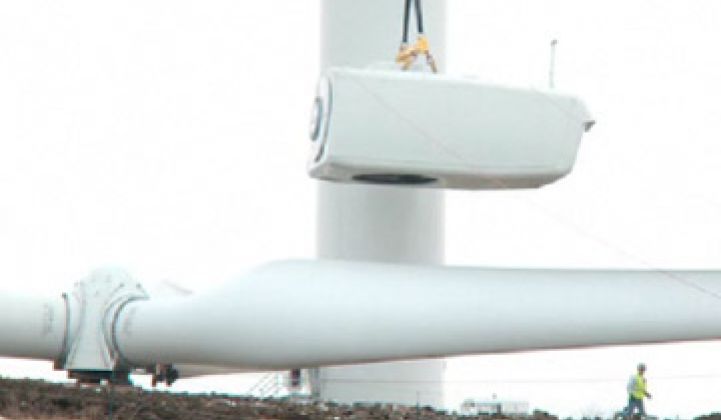Tom Carnahan, President and CEO of Wind Capital Group, was a St. Louis attorney in 2005 and wanted to get into renewables. Surfing the web, he found a map of the U.S. at the American Wind Energy Association (AWEA) website. States with wind farms were colored in. “Everything in the Midwest was colored in except Missouri,” he said.
No Missouri wind farms had been built, Carnahan discovered, because “nobody had ever tried it.” Experts told him, “you can’t do wind power in Missouri. It’s not going to happen.” A lifelong resident of the Show Me State, this resistance only hardened Carnahan’s resolve to do it.
He selected a likely site and began taking wind readings and studying transmission. Then he went to meet with farmers. “I know this has never been done before,” he recounted telling them. “Wind Capital Group will treat you right. Will you put your faith in me?”
Carnahan said it is vital to form good partnerships with key stakeholders “and remind them of the benefits of wind.” And, he added, “if there are concerns, address them in a transparent way.”
Engagement with landowners, he found, must be personal. “You call them up. You knock on their door,” he said. “You’ve got to spend some time sitting at the kitchen table, drinking some coffee and talking to folks.” He smiled. “These people in rural America, and farmers in particular, have very well-honed BS detectors. You only get one chance to be shooting straight with them and you’ve got to do that.”
He still remembers the thrill when he felt when the group of Missouri farmers he was meeting with in a King City café agreed to sign on to his plan.
“I had two big tasks after that,” Carnahan said. “Figure out how we were going to finance it and who was going to buy the power.” Studying wind investors, he found “a lot of folks with addresses in New York, but then there was John Deere.” The Midwest-based farm equipment conglomerate (soon to become a subsidiary of power giant Exelon) was investing in wind and bought into Carnahan’s ambition.
For a potential partner in a power purchase agreement, he went to Missouri’s Rural Electric Cooperatives. Formed to facilitate the depression-era Rural Electrification Act (REA), co-ops remain an important alternative to investor-owned and municipal utilities in many agricultural regions.
Carnahan showed his project’s wind profile to Associated Electric and told them John Deere was considering financing it. “They were skeptical at first, but after an hour or so of talking, they wanted to know more,” Carnahan said. “Wind represents an enormous opportunity for rural economic development,” he added, something co-ops he has worked with understand. “They’re an important part of our plan,” Carnahan said.
Within several months, “We had a fully negotiated and executed power purchase agreement,” he said, “and six months later, we were under construction with Missouri’s first wind farm.” Two 50.4-megawatt developments followed, as did an atypically small 5-megawatt installation. “The community wanted us to do that,” he said. “On any given day, it powers the entire city of Rockport, Missouri.”
“Our business model shifted after that,” Carnahan said, to “developing projects and transferring them to utilities.” In that mode, Wind Capital Group built a 200-megawatt wind farm in Iowa and a 400-megawatt wind farm in Minnesota and successfully sold both.
Carnahan said Missouri’s 2008 voter-instituted Renewable Energy Standard (RES), requiring the state’s utilities to obtain fifteen percent of their power from renewable sources by 2021, had little impact on his planning, because the “RES is a great tool for creating demand, but it doesn't significantly impact the project financing for a non-merchant facility.”
And financing was on Carnahan’s mind. He had decided Wind Capital Group should become a wind project owner-operator. Dublin-based multinational NTR, the first investor in the pioneering Irish wind developer Airtricity, had just sold those assets, was looking to reinvest in North American wind and found Carnahan’s company to its liking.
With NTR backing, Carnahan this year completed his first owner-operator project, the 150-megawatt Lost Creek wind farm in Missouri. They brought the project in on time and ahead of budget, overcoming significant challenges along the way, “not the least of which was the significant financing deal that we closed on in October of last year” despite the economic crisis.
The Lost Creek project required persistence, a sound plan and five of the world’s largest lenders. “They knew we would have an executable deal.” His company is so capable, Carnahan said, because of “our people.” They “share my entrepreneurial mindset and we like to punch above our weight.”
“It’s a very competitive industry,” Carnahan said, but “I don’t spend a lot of time thinking about our competition. We find good projects with good capacity factors that have a transmission advantage and that have a community that wants us there. I’m convinced that if you have those things you will build a project.”
Carnahan expects to start his biggest independent build yet in 2011. “When we financed Lost Creek, there might have been half a dozen banks in the market. We see that as over 30 sitting here today. We think there is capacity in both the bank and the tax equity markets.”
Carnahan's outlook remains forward leaning. “Our relatively small size allows us to be lean and nimble and move to new market opportunities,” he said. “In the same way that nobody had built a wind farm in Missouri in 2005, we’ll continue to look for these new markets that become available as technology improves.”



